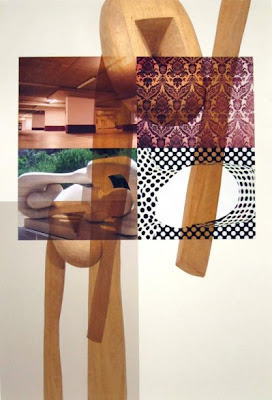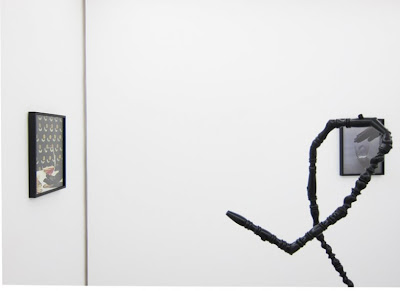Currently on view at The Goma in Madrid, Spain is Ernesto Burgos: Notes in the Margin . The exhibition, the artists first solo in Europe, features sculpture installation and appropriated, photographic, framed images. Ernesto, originally from Santa Clara, California and currently based in NY, deconstructs familiar objects in order to find various ways of communicating within the context of a room and the viewer. Notes in the Margin finds the artist, who while in Spain, made most of the work for this show, focusing on a particular spatial dissemination, removing information in order to fulfill his own artistic agenda.
For Your Presence on Their Presence, the artist has chosen to reference an essay by Norman Mailer about graffiti. The title correlates with the physicality of graffiti (human interference) on the surface of a public structure. Burgos tends to look at the interaction with his own art and the process of making objects in a similar way. He makes abstract marks and interferes with space constructing something sculpturally precise and intermixed with matter (such as painting t-shirts, rags) that normally wouldn’t be combined. Materials from works are often recycled and sculptures can be interpreted as three-dimensional drawings. It is in this format that the artist builds upon a body of work, each piece somehow interacting with the other.
Several of the image based works in Notes in the Margin are collages, such as Untitled (Noguchi Stick), 2011, made using appropriated and manipulated images along with photographic C-Prints, utilizing liquor advertisements from the 1960’s. All of the commercial information has been removed. The focus of each particular method of execution, photography, sculpture, and collage extends from the same thought process, altering the original intention of an image or object to provide a certain level of urgency contrasting with what one might expect. Choosing to utilize alcohol advertisements, Burgos attempts to renounce the gesture of the hand and proposed movement. Sans text, the viewer is left with what has become a still-life of sorts. A hand reaches out and touches a glass, or in a moment of contention, barely grazes the surface. Within this frame of reference, obsession builds and flesh becomes a compositional element of desire. The artist views this moment of reaching towards the alcohol laden glass to mirror the inherent longing for substance/content/material prevalent in the theory of addiction. Conceptual at its base, he attempts to comment on the natural inclination for a viewer to seek out meaning in artwork, however ironic and within a contemporary art context, his goal is the complete antithesis of meaning, void of specific purpose.
From the artist on his process and selection of appropriated images:




